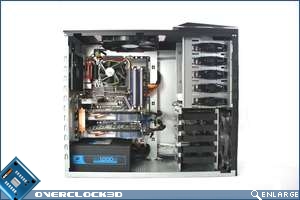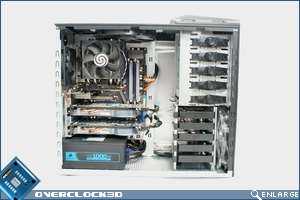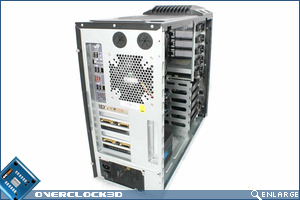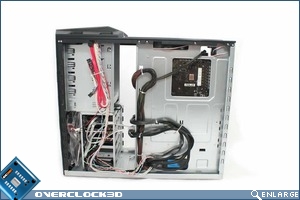Cooler Master HAF 922 ATX Case
Installation & Testing
Â
Being an enthusiast gaming case we decided to test this with some full size enthusiast hardware. We chose to use an oversize power supply and a pair of double slot cards to help show that this case’s size doesn’t stop you fitting a high end system.
Â
Test set up
Intel Core2Duo Q6600
Intel stock HSF & Nexus HOC-9000
Asus Rampage Extreme
4gb Corsair XMS3 PC3-12800 Ram @ 9-9-9-24 1.9v
2x HIS 4870 1gb IceQ 4+
Corsair HX1000w
Western Digital VelociRaptor 300gb
Windows 7 Release Candidate
Â
Â
Not only is the case big enough to swallow all the test kit, but its tidy too thanks to the amount of cable options. Even the back of the motherboard tray is fairly tidy with 5minutes work and some cable ties. The case feet do not give much clearance beneath the case so if you decide to mount your power supply facing down as we have then limited airflow may become an issue.
Â
Â
Â
Testing
Â
Idle temperatures were taken after thirty minutes of booting up, and load temperatures after thirty minutes of torture tests using Prime95 to max out the 4 cores. Ambient temperature during testing was 22c controlled by an air conditioner. The 922 was tested against a Lian Li PC7 for comparison, we also tested with a stock Intel heat sink and a Nexus HOC-9000 to simulate low/high end HSF differences. The CPU was put through 2 tests stock and overclocked. Stock was with the bios all on auto no changes made at all. Overclocked the vcore was raised to 1.5v, the FSB to 400 and the multiplier set to 9, speedstep was disabled, all other settings were left on auto.
Â
• HW-Monitor – record and monitor all temperatures
• Prime95 – CPU & Ram testingÂ
• HD Tach – To Simulate Random Reads on the hdd
• ATI Tool – GPU testing
Â
Â
Even at idle the 922’s increased airflow compared the PC7 has a noticeable impact on temperatures. The thermal cut out on the Rampage was set at 90c and as the Intel heat sink could not cope with the Quad Core CPU when over clocked, the system shut down due to heat in the PC7 after just 8 minutes. The 922 how ever just about held it together for 30minutes and only reached a maximum over clocked temperature of 82c, really does show how much of a difference that roof fan makes.
Â
Â
Normally on OC3D we only use the Intel stock fan, but for a change we thought we would run the same tests with a good aftermarket cooler as well so you can compare them both. The PC7 isn’t the biggest case in the world so finding a heat sink that cooled well but also fit was a challenge. The Nexus HOC-9000 with its vertical style mounting means you can get a much bigger heat sink in a smaller space, it also helps keep the motherboard and VRM’s that bit cooler seemed perfect. Once more this is a place where the 922 wins hands down, as the case is noticeably wider than the PC7 and can easily accommodate even the largest heat sinks.
Â
Â
Even when fitted with the Nexus the PC7 just hasn’t got the airflow to be able to keep an over clocked quad cool. The temperature gap is smaller on the graphics cards but I’m sure if you installed a fan or two in the 922’s side panel then the GPU’s temperatures would plummet. Its easy to see on the graphs on every test the 922 has been significantly cooler, but without seeming any louder.
Â
Â
Testing done, lets move on to the final conclusion..Â






